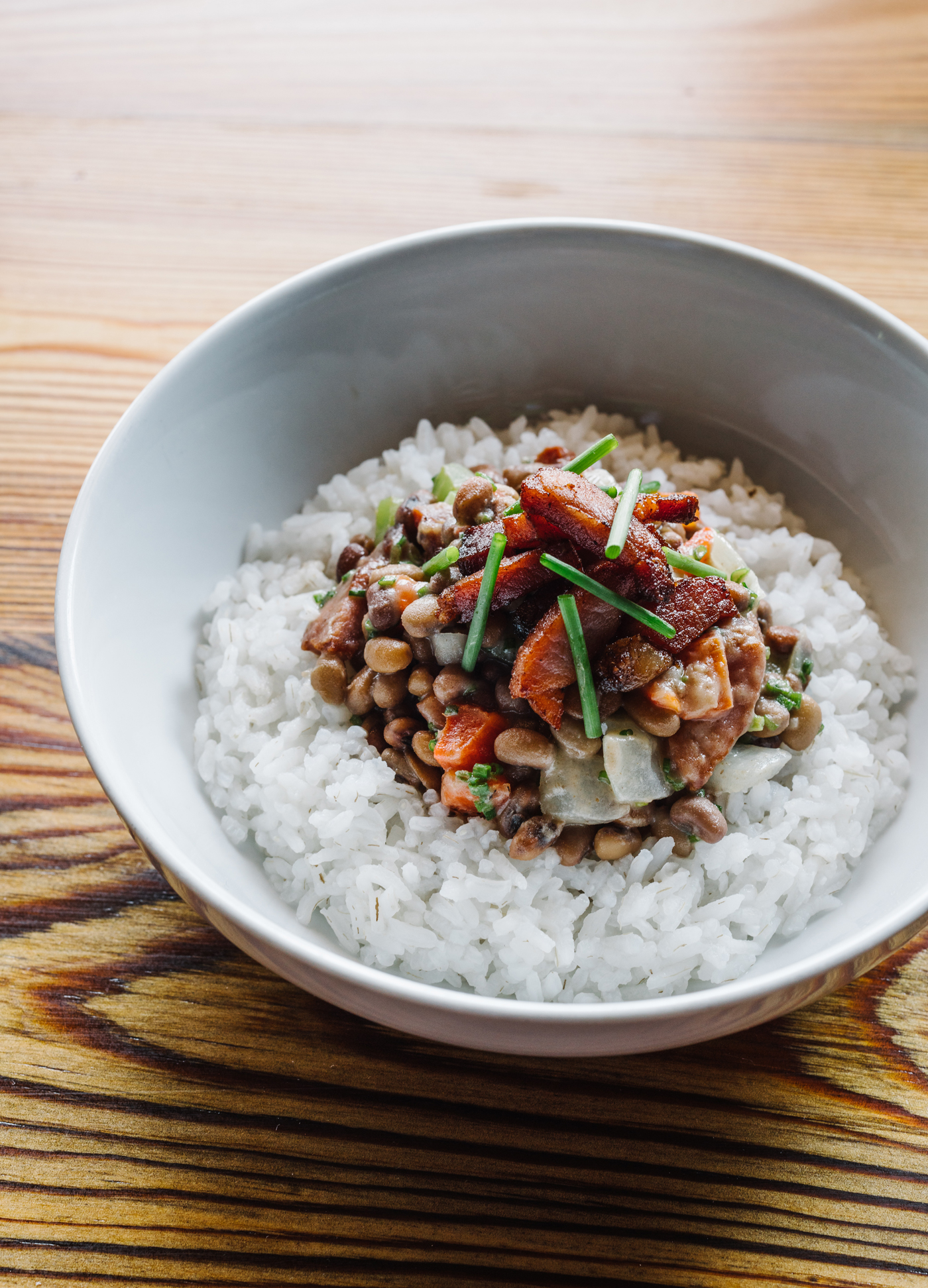GOOD FORTUNE When I met Hoppin' John
by Osayi Endolyn (Gravy, Summer 2016)
“What’s Hoppin’ John?” I asked no one in particular. It was 2013, and I was working as a host and server’s assistant at Empire State South in Midtown Atlanta. Jason Zygmont had just brought out family meal during line-up, when the staff would discuss the night’s menu and upcoming reservations and wolf down simple dinners like grilled cheese sandwiches and tomato soup, or penne pasta with veggies. At Empire State South, the cooks cure meat, filet whole fish, pickle vegetables, hand-roll pasta, ferment hot sauces, and tweezer-pluck bulbs from wild flowers. Family meal is necessarily no-frills. But that day, Jason treated us to a feast of herb-encrusted chicken, sorghum butter–topped cornbread, and Hoppin’ John. As he disappeared into the kitchen to finish prepping for service, the hum in the room rose with gratitude.

When I asked my question, Darnell Perkins, a veteran server from Jackson, Mississippi, raised an eyebrow. “Black-eyed peas…” he trailed off, waiting for things to click. They didn’t. He told me that Southern cooks made Hoppin’ John with peas and rice, seasoned with onion, pork, and sometimes various peppers and spices. He said that it was good luck to cook on New Year’s Day, and he set the origins of the dish in Lowcountry South Carolina.


I peered into the serving bowl. The contents looked comparable to a black-eyed pea dish my Nigerian dad made. It tasted familiar, too. My mom, a Los Angeles native, born to a Mississippi mother and a Louisiana father, had sometimes cooked black-eyed peas for New Year’s Day. Still, I had never heard of this dish before. In a household where one parent was the West Coast product of black America’s Great Migration and the other was born in Nigeria, I wondered how this staple dish, seemingly rooted in West African and African American traditions, could escape me.
This food, this history, had traveled far—why not far enough to reach my dining table?

Though he never said it outright, my father’s kitchen philosophy, which I learned as a child, was, “A man needs his space.” Neither I nor my two younger brothers were invited to the party. When Dad cooked, the kitchen was his alone. My father made what he liked to call “real food.” Sometimes I’d feign thirst to gain kitchen access. I’d linger in front of the refrigerator water dispenser, watching Dad blend a mash of tomato paste with diced white onion, then scrape it into a giant, sizzling pot, smoking with hot palm oil.
“What are we having?” I asked once, taking a sip. “Stand back,” he said over the crackle of searing liquid. He didn’t meet my gaze. Dad would only tolerate my hovering for a few moments before banishing me from the kitchen— “anywhere but in here.”
For the big dinnertime reveal, the five of us sat down at the birch oval dining table, my father’s iron curtain finally withdrawn. My feet barely grazed the floor. I would crane my neck as Dad carried piping-hot serving bowls toward us. More than two decades passed before I learned what went down after the palm oil entered the stew pot. I have a clear recollection of the result: a bowl of bright orange egusi soup, marked with ground melon seeds, wilted bitter leaves, crawfish, and dark chicken meat. Each place setting hosted a steaming ball of pounded yam. We would pull off a piece of the doughy material with our fingers, shaping it into a perfect disc, and then dip the eba, as my father called it, into the deep-flavored, pungent stew.

I don’t know when I began to identify dishes like jollof rice, moin moin, and akara as Nigerian food.
I don’t know when I began to identify dishes like jollof rice, moin moin, and akara as Nigerian food. My father, born of the Edo tribe, never called them that. He didn’t think of the dinners he prepared as ethnic or unique. This was just what we ate, part of a rotating cast of dishes that appeared in my central California household in the mid-1990s—tacos, spaghetti with store-bought sauce, tofu everything, and moo shu pork. Nigerian food stood out because that was all that my father cooked.
At the Empire State South family meal, I was reminded that Nigerian food hadn’t been part of my repertoire for some time. I barely even knew where to source ingredients, much less how to cook the classic dishes. At the same time I noted that chasm, I began to realize that the food my father cooked in those giant metal pots, the recipes he cooked from memory, were deeply connected to the artfully plated, labor-intensive New Southern dishes I had begun serving, at $30-plus per entrée, to Empire State South patrons. The night I met Hoppin’ John solidified those observations. I felt both loss and solace. Perhaps I had missed something integral. But the familiarity of Hoppin’ John encouraged me. A part of this centuries-old food story belonged to me, even if I hadn’t heard the whole narrative before. I wanted to fill in the missing parts.

Following the divorce of my parents, my brothers and I relocated with my mother. I had been fearful of my father for some time. In public, he was charming, effusive, and entertaining; everybody’s favorite African. In private, he could be unpredictable, violent, and dismissively mean. I grew to genuinely dislike him. When my mother left my father, I saw her decision as a necessary step. He fumed, “A woman can’t just leave her husband.” A woman can and my mother did, moving us more than 300 miles away. But my dad’s anger hovered over us like a shadow. After a while, memories of his meals failed to conjure warm feelings. With him went the egusi, the goat meat tomato stews, snacks like chin chin, roasted coconut, and fried puff puff. By the time I was fifteen, I had lost my taste for Dad and his food.
With him went the egusi, the goat meat tomato stews, snacks like chin chin, roasted coconut, and fried puff puff. By the time I was fifteen, I had lost my taste for Dad and his food.

In 2006, I began to forge a new relationship with my father, almost eleven years after our stalemate. As a twentysomething crafting my own identity, I began to explore what Nigerian culture could mean to me. Years later, this shift deepened when I worked at Empire State South. During line-up meetings, we discussed Southern ingredients of West African descent, like benne seed and Carolina Gold rice. Chefs across the region were embracing and expanding on their Southern identities. Suddenly, I had a framework for asking questions about my own Southern heritage, my father’s culture, and my relationship to the foods that branch from both sides of my family tree. Growing up, we didn’t eat Hoppin’ John. We savored ewa dodo, a chunky black-eyed pea stew made with fish, chopped tomatoes, and chili peppers, and served with a side of fried green plantain. Flavored with the umami of a Maggi bouillon cube (in West African cuisines, it’s always about the Maggi—regardless of its high sodium content and hydrogenated oils), the thick stew cooked down to tender bits that Dad spooned over rice. For his rice and beans, he cooked both in the same pot. I didn’t know then that slave traders had brought black-eyed peas (or cow peas, or field peas) as provisions for African slaves throughout the Americas. In countries like Cuba and Brazil, they still appear in a range of culturally distinct dishes. At first I didn’t equate Hoppin’ John, with its pork hunks and fluffy rice, as a complex symbol of home and sustenance. It just reminded me of how Dad ate. Only later did I understand that black-eyed pea dishes were how we ate.
Growing up, we didn’t eat Hoppin’ John. We savored ewa dodo, a chunky black-eyed pea stew made with fish, chopped tomatoes, and chili peppers, and served with a side of fried green plantain. Flavored with the umami of a Maggi bouillon cube (in West African cuisines, it’s always about the Maggi—regardless of its high sodium content and hydrogenated oils), the thick stew cooked down to tender bits that Dad spooned over rice. For his rice and beans, he cooked both in the same pot. I didn’t know then that slave traders had brought black-eyed peas (or cow peas, or field peas) as provisions for African slaves throughout the Americas. In countries like Cuba and Brazil, they still appear in a range of culturally distinct dishes. At first I didn’t equate Hoppin’ John, with its pork hunks and fluffy rice, as a complex symbol of home and sustenance. It just reminded me of how Dad ate. Only later did I understand that black-eyed pea dishes were how we ate.
Talking with my father now is harder than it’s ever been. Not because of personality conflicts or past frustrations—he has suffered multiple strokes. Over the years, partial facial paralysis and impaired cognitive function have made it nearly impossible to understand his formerly verbose and loquacious English. Perhaps I caught him on a bad day, but when I phoned to ask him what he knew about Hoppin’ John, he became confused. The conversation, one-sided as it was, fizzled.
I suspect that, like several Nigerian cooks and restaurant diners I’ve met, he would not be shocked that so much Southern cuisine developed from the practices of enslaved West Africans. Sure, rice, okra, black-eyed peas, and yams may be sacred to certain parts of our collective American culinary identity. No matter. Please pass the fufu. My father did not require this knowledge to define his identity. As complex as Nigerian history is, he knew his place in the story, which didn’t require the narrative of forced migration and the foods that came with it. I recognized that while Dad was satisfied with his self-portrait, I could only sketch part of mine.
The alarm I felt at my ignorance of black American identity grew into the pride of a second-generation immigrant.
When I tasted my first Hoppin’ John at family meal, the sense of familiarity intensified. This was nothing like the robust flavor of my father’s ewa dodo. The taste was much smoother and lighter. Yet when my friends and coworkers dunked pieces of cornbread into the dish, I recognized that this was the way we dipped pieces of plantain into my father’s ewa dodo. The alarm I felt at my ignorance of black American identity grew into the pride of a second-generation immigrant. I knew this dance. We’d been here before. Hoppin’ John and I were late to meet each other, but we’d been family since way back when.

Osayi Endolyn’s writing explores food, culture and identity. Her work appears in the Oxford American, the Washington Post, the Wall Street Journal, and Eater.
Photos by Andrew Thomas Lee. Illustration by Katy Clune.




